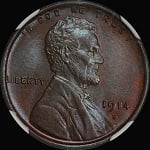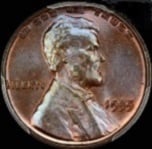Is there a difference between a Terminal Die and a Shattered Die?
I've seen coins that had a description of a "shattered" die and other ones that were described as having a "terminal" die state and, to me, they look pretty similar. Is this just a difference in terminology or is there a significant difference in the die?
0



Comments
--Jerry
<< <i>I'm no expert by any means, but my interpretation is a shattered die state is the result of continued use of a terminal die. >>
Not all dies will shatter. a properly annealed die should never crack. To shatter, a die needs to be brittle=too hard=inadequately annealed.
Of course if you over anneal it, it will be soft and erode quickly.
--Jerry
Keeper of the VAM Catalog • Professional Coin Imaging • Prime Number Set • World Coins in Early America • British Trade Dollars • Variety Attribution
This ones pretty shattered, how close to terminal I have no idea. Sorry it's not copper
Terminal = so badly cracked that it likely fell apart not long after the subject coin was struck. Might have weak parts of design due to metal failure.
The Penny Lady®
Keeper of the VAM Catalog • Professional Coin Imaging • Prime Number Set • World Coins in Early America • British Trade Dollars • Variety Attribution
and thanks for all the answers, Im printing this out for the club so does anyone else have any
more example pics to share?
is there maybe a website with pictorials to this?
Go BIG or GO HOME. ©Bill
this Conder token has a pretty dramatic "terminal" die state.
So, with these two examples, one can certainly see the difference but I am still wondering when and if "shattered" dies become "terminal" dies and if some people use the terms interchangeably.
The Penny Lady®
You seem to be confusing the physical condition of the die, with how the dies was used. Both "shattered" and "terminal" refer to the die's condition, not to the pieces that might be struck from it.
<< <i>A "shattered" die has already had pieces missing. Coins struck from that die will have blank areas.
You seem to be confusing the physical condition of the die, with how the dies was used. Both "shattered" and "terminal" refer to the die's condition, not to the pieces that might be struck from it. >>
RWB, no, I am not confusing the difference between the die and the struck coin, but your response seems even more confusing to me since from what I've seen, shattered dies are the ones that have mostly cracks with no chunks missing, whereas coins struck from terminal dies seem to show indication that those dies might have very large cracks as well as pieces missing from the die. Perhaps that may be vone of the differences between the two terms?
The Penny Lady®
"Shattered is a physical description of the die. Terminal is a temporal description of the die's life. Neither the set of coins showing shattered dies nor the set of coins showing terminal die states is a subset of the other."
Absolutely correct and rather well stated.
Not all shattered dies have pieces missing, as with a cud. A shattered die simply means a die with extensive die cracks. As messydesk states, this may or may not be a 'terminal die state', however.
"Three or more die cracks radiating toward the center of the die, usually 90 degrees apart, indicates that the die has begun to shatter into several pieces."
"Terminal die state" is overused and usually in error, as true terminal die states are rare and often unique, and may only represent the latest known die stage, as 95+ % of US coins have not survived. "Late die stage" is usually more appropriate terminology.
These two quarters are from a shattered dies per CONECA's defintion, but they are not terminal, and not the latest die stage:
This coin is from a split die per CONECA's definition, but not terminal as there is a later die stage:
A full cud or split die may not be shattered, according to CONECA's terminology, depending on whether a third crack is present.
<< <i>I think messydesk gave the very best definitions of 'shattered die' and 'terminal die state' in his initial post, before he rephrased it:
"Shattered is a physical description of the die. Terminal is a temporal description of the die's life. Neither the set of coins showing shattered dies nor the set of coins showing terminal die states is a subset of the other."
Absolutely correct and rather well stated.
Not all shattered dies have pieces missing, as with a cud. A shattered die simply means a die with extensive die cracks. As messydesk states, this may or may not be a 'terminal die state', however. >>
I like both of Messydesk's descriptions. Terminal means last die state known. Doesn't have to be shattered.
Being shattered just makes it easier to identify, which is why so many "terminal die state" coins happen to be struck from shattered dies. That may be why many people equate one with the other.
TD
The Penny Lady®
Through the blessings of C-clamps, a shattered die can actually produce one whole heck of a lot of coins. Indeed, if a die shatters in the cooling/quenching process, the shattered state could actually be the early die state! When pieces start falling out, you start curving towards terminal. At some point, a coiner starts whistling Boyz II Men "End of the Road," and pulls the die from service. Unless he saved a coin produced at the moment and labeled it as the last one struck, it's impossible to say exactly what the finalfinalfinalfinalfinal die state is.
But, like Whizzer White, sometimes you just know it when you see it.
Betts medals, colonial coins, US Mint medals, foreign coins found in early America, and other numismatic Americana
I'm using the "shattered" terminology that engraver Morgan used in Dec 1921, when high relief peace dollar dies fell apart in use. Shattered dies are, by definition, incomplete because pieces are missing. If all the pieces are present so that coins can be struck, the die might be in very poor shape, but it has not shattered into fragments. (The die can still produce a complete coin, regardless of the number of cracks.)
Maybe it is like the Breen-isms "wire edge" and "rolled edge" - nonsense terms that confuse more than describe.
I agree with what others have said that it doesn't matter if a die is "shattered" or not; it doesn't necessarily have any bearing on if the die is "terminal" or not. A die could simply have incredibly worn out surfaces and no die cracks and be "terminal."